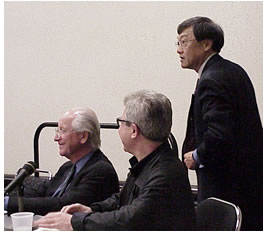
The AIA online continuing education site, eClassroom, just posted five programs derived from five of the most popular seminars at this year's AIA national convention in Denver. An eight-minute segment from one of the courses is available free as a sample of how the audiotape and slide presentations work together to recreate the seminar experience.
The five courses each carry two AIA/CES learning unit hours, which encompasses the time required to take the course and complete the quiz. For AIA members, the eClassroom system automatically notifies the AIA/CES record keepers of the earned learning units. A printed transcript is available for nonmembers. Two of the new courses cover health-safety-welfare topics. The cost for each course is $99.95 for AIA members and $149.95 for nonmembers.
 The
course sampler is taken from the amusing and informative talk by Michael
Graves, FAIA, and Daniel Libeskind on urban design for the future. (The
opening eight minutes feature Graves' slide show introducing the concept
of object and figurative space.)
The
course sampler is taken from the amusing and informative talk by Michael
Graves, FAIA, and Daniel Libeskind on urban design for the future. (The
opening eight minutes feature Graves' slide show introducing the concept
of object and figurative space.)
The five new courses:
S13 Real Estate
Development Fundamentals: How to Utilize Architectural Skills to Develop
Real Estate Projects
Increase an architect's financial control and understanding of the development
process, and you expand his/her role at the project initiation stage.
You'll hear about strategies, processes, project descriptions, pro formas,
and project histories from three architecture firms that became their
own best clients by developing real estate projects.
You'll learn:
• New business strategies that put architects in the driver's seat
on making their own projects happen
• Basic financial feasibility analysis and how to seek out and initiate
project development opportunities
• The components needed for compiling a real estate development pro
forma and how to adjust the numbers to reach a financially successful
conclusion.
Course presenters: Brad Buchanan, AIA; J. Richard Kremer, FAIA; and
Chris Widener, FAIA.
S36 Eight Ways to
Negotiate More Profitable Fees
As traditional architectural services become more merchandised, clients
expect to pay lower, more competitive fees. Profitable firms employ specific
negotiating strategies and are perceived as providing unique services
and/or delivering exceptional results. After examining how clients evaluate
fees, you'll learn how to change clients' perceptions of the value architects
provide and see ways to communicate the value for which clients are willing
to pay more.
Learn how to:
• Present fee proposals that communicate the value of the architect's
fees and services from the client's perspective
• Focus discussions on areas of greatest profit potential
• Differentiate your architecture firm in order to command better
fees
• Negotiate fees based on value provided
• Incorporate favorable fee provisions and avoid dangerous ones.
Course presenter: Michael Strogoff, AIA.
S64 Design-Build:
Yesterday, Today, and Tomorrow
Design-build is becoming an increasingly popular delivery method for architects.
The panel examines the influence of design-build on the profession of
architecture, how to define the scope of work in an agreement, the liabilities
involved when doing design-build, and the AIA's contract documents.
You'll learn:
• What issues and liabilities to be aware of when doing a design-build
project
• What changes are proposed for the AIA's family of documents
• How to effectively use agreements to address crucial issues and
liabilities.
Course presenters: Edward Rothe, FAIA; Paul G. Sieben, FAIA; and Timothy
Twomey, AIA, Esq.
S125 Designing for
the Future: Urban Thinking
This panel of prominent architects, including 2001 AIA Gold Medalist Michael
Graves, FAIA, will inspire you with their broad and historic perspective
on current trends in architecture as they relate to issues of livability
and aesthetics.
Learning Objectives:
• Review the responsibilities of architects as key determinants in
the quality of life in society
• Learn the impact of the built environment
• Discover the qualities, ideas, and practices needed to achieve
architectural excellence.
Course presenters: John Anderson, FAIA; Gordon H. Chong, FAIA; Michael
Graves, FAIA; and Daniel Libeskind.
S135 Crafting High
Performance Buildings—A Roadmap for Commercial Buildings of the 21st
Century
For the last two years, more than 250 building-industry representatives
from more than 150 organizations have been developing a Technology Roadmap
for High-Performance Commercial Buildings. Facilitated by the U.S. Department
of Energy, the Roadmap prescribes a 20-year plan and set of four strategies
for achieving healthy, productive, and high-performance commercial buildings.
You'll :
• Learn about new and emerging technologies that will affect the
way tomorrow's buildings are designed, operated, and maintained
• Be introduced to collaborative design models that help create high-performance
buildings
• Investigate resources for designing and operating high-performance
commercial buildings: Web sites, software, tools, guidelines, standards,
and materials.
Course presenters: Drury B. Crawley, AIA, and Gail A. Lindsey, FAIA.
Copyright 2001 The American Institute of Architects. All rights reserved.
![]()
|
To find out more, take one of these courses, or get a free mini-lecture by AIA Gold Medalist Michael Graves, FAIA, click here. |
|